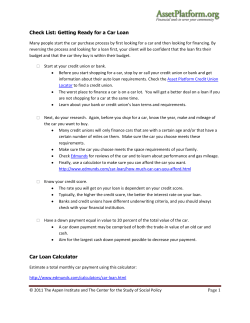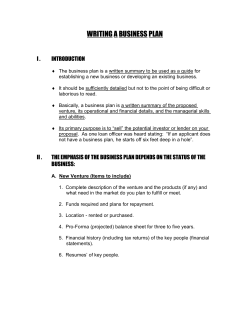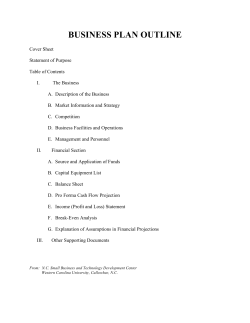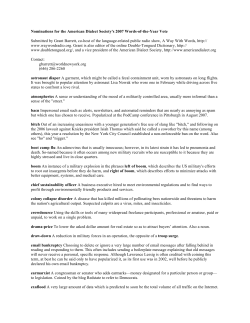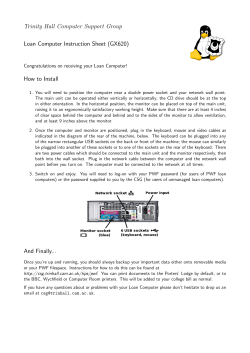
How to Draft Project Proposal Sungsup Ra Sr. Country Programs Specialist
How to Draft Project Proposal Sungsup Ra Sr. Country Programs Specialist Nepal Resident Mission Asian Development Bank May 2005 1 ADB Program and Project Cycle FREQUENTLY USED ACRONYMS ADTA ADBBO ADF CPM CSC CSP DMC ETSW JSF JFPR JFICT MRM NLPS NPRS OCR PA I PA M PA U PPTA PRF RETA RRP SRC TA TASF TOR 2 – – – – – – – – – – – – – – – – – – – – – – – – – – advisory technical assistance ADB business opportunities asian development fund country programming mission consultants selection committee country strategy and program developing member country economic/thematic/sector w ork japan special fund japan fund for poverty reduction japan fund for information and communication technology management review meeting nonlending products and services for poverty reduction ordinary capital resources project administration instruction project administration memorandum project administration unit project/program preparatory technical assistance poverty reduction fund regional technical assistance report and recommendation of the President staff review committee technical assistance technical assistance special fund terms of reference Overall View of ADB Assistance Types of ADB Assistance 3 • Loans (Project loans, Program loan, Sector Developments loans) • Equity Investments • Technical Assistance Grants (PPTA, ADTA, RETA) Overall View of ADB Assistance Source of Funds - 4 Loans: OCR and ADF TAs: TASF, JSF, and others (JFPR, JFICT, NPRS, and PRF) Six Major Stages Evaluation Implementation Loan Negotiation and Board Approval 5 Identification Preparation Appraisal The Project Cycle Identification Evaluation Implementation Loan Negotiation and Board Approval 6 Preparation Appraisal The Country Strategy and Program (CSP) defines the country’s development objectives and a pipeline of projects. The project concept paper states the purpose and rational of the project and seeks approval to proceed with the PPTA (project preparatory technical assi stance). The Project Cycle Identification Evaluation Implementation Loan Negotiation and Board Approval 7 Preparation Appraisal The project must be designed in detail, with steps including PPTA fact finding, PPTA Inception PPTA mid-term workshop, and finalization of the PPTA. All beneficiaries are encouraged to have input into the design and indicators are selected to measure project effectiveness The Project Cycle Identification Evaluation Preparation Implementation Loan Negotiation and Board Approval 8 Appraisal A management review meeting and appraisal mission provide the basis for interdepartmental review and set the stage for loan negotiations and board consideration The Project Cycle Identification Evaluation Implementation Preparation Appraisal 9 Loan Negotiation and Board Approval After project appraisal, Negotiations are conducted Between ADB and DMC Governments. An RRP is prepared for Board consideration and approval. The Project Cycle Identification Evaluation Implementation Preparation Appraisal Loan Negotiation and Board Approval 10 Project Administration Memorandum (PAM) is prepared with detailed i mplementation Arrangements. The project is Implemented in accordance wi th the Project Administration Instructions (PAI). The Project Cycle Evaluation Implementation Identification Preparation Appraisal Loan Negotiation and Board Approval 11 All projects are evaluated, with results fed back into operations for improvements in future project designs. 11. Evaluation 1. Country Strategy and Program – Identification of Projects 2. Feasibility Study, PPTA Preparation 10. Completion 9. Supervision, Monitoring & Reporting The Project Cycle 4. Loan and ADTA Processing 8. Project Implementation 5. Loan Negotiations 7. Loan Effectiveness 6. Loan Approval 12 3. PPTA Implementation ADB’s Project Cycle Project Cycle •Country Strategy and Policy •Project Identification Design Identification PPTA Fact Finding Preliminary Design Implementation •Design of Project Preparatory Technical A ssistance •PPTA A pproval PPTA Inception •Inception workshop (Detailed TOR agreed) PPTA Mid Term •In-depth project analysis •Mid-term workshop •Engineering Design, Cost estimates, Fina ncing Plan, Impleme ntation A rrangements, etc PPTA Final 13 Key Activities •Final Tripartite Workshop Appraisal •Management Review Meeting •Loan A ppraisal Mission •Loan Negotia tions •Board A pproval Start-Up •Project Management Consultants Implement Detailed Design Documents Project Concept Paper PPTA Paper Feasibility Study (Progress) Report Feasibility Study (Final) Report Project Proposal for Board A pproval PAM •Quarterly Progress Reports PPR •Completion of project PCR PPA R Monitor Completion Evaluation Approaches to an Ecommunity Center Project Types of Investment - Commercial initiatives by enterprises or communities - 14 Social initiatives by NGOs or CBOs Government initiatives Approaches to an Ecommunity Center Project Types of Services - E-government - Education - Communication - Agricultural services - Entertainment - Health services - Other community/religious services 15 Operational Challenges - High Initial Cost - Severe Infrastructural Obstacles - Dependency on Good Operators - Sensitive to Location and Population Density - No Single Killer Applications 16 Technology Needs - Power Management - Connectivity - Rugged Hardware - Language Localization 17 Recommendations - Local Participation - Community Ownership - Establish Effective Operations and Maintenance System 18 Performance Matrix Capacity Measures Organizational Operational Strategic Goals Mission Process User Inform ation Educational Background Hardware •Uptime •Size of user community •IT literacy •Computers processors speed •Response time •% of target population using •General literacy •Terminals •Local language cov erage •% of local population using •Increase school capacity •Printers •New and repeat users •Access to information •Copiers •% of local population with access Activity Information •Social Development •Other equipment •Access to information providers •Av ailable hours •Av erage time online and offline use •Healthier population •Age of equipment Software •Capacity utilization •People taking classes •Reduced mortality •Programs: Ty pes and Age of Programs •System, power, and telecom reliability •Sites visited per user •Economic dev elopment •Look Look--ups per site •Farm productivity •Online transactions •Employ ment •Time system used •Reduced transaction costs •Health consultations •Reduced poverty •Gov ernment correspondence •Wealth creation Telecom •Bandwith capacity Ty pes of links Expertise •Technical help availability • Application help Financial •Rev enues f rom grants •Rev enues f rom fees and ads •Operating selfself -sufficient •Internal rate if return 19 Im pact Measures Services Offered •Serv ices scope •Diff erent class and class hours offered •Online and offline classes •Community links Intranets •Software package usage •Other equipment usage •Community building and safety Outline of a Simplified Project Proposal I. Introduction II. Proposed Project - Objective and Scope - Cost Estimates and Financing Plan - Implementation Arrangements - Implementation Schedule - Technical and Economic Justifications - Project Framework (Appendix) 20 Sample Project Proposal Project Name: Community Information Services for the Poor Borrower: Democratic Socialist Republic of Sri Lanka 21 Objective and Scope - Create opportunities for the poor by providing vital information - Pilot community information networks in two districts - Examine ground for services - Provisions of case studies how services can effectively reach poor and disabled 22 Project Introduction Three main components: - Establishment of two community information networks - Capacity building - Provision of information services 23 Cost and Financing Plan Total Cost: $1.1 million Poverty Reduction Cooperation Fund: $800,000 Cofinancing: $100,000 Government’s contribution: $200,000 24 Cost and Financing Plan Item F oreign E xchange Local C urrency Total Cost 0.0 250.0 250.0 A. Asian Development Bank 1. C onsultants a. Remuneration and P er Diem b. Local Travel 0.0 30.0 30.0 c,. Reports and New sletter 0.0 30.0 30.0 20.0 150.0 3. Training and Workshops 0.0 2. E quipment 130.0 20.0 20.0 4. C ase S tudies and 20.0 Researches 5. M otor Cyc Cyc.. And Vehicle 30.0 Rent 6. M isc. A dministration 0.0 10.0 30.0 10.0 40.0 10.0 130.0 130.0 0.0 10.0 7. Representativ e for Contract 8. C ontingencies 47.0 63.0 110.0 S ubtotal A 237.0 563.0 800.0 30.0 0.0 30.0 B. Cofinancing 1. C onsultants 2.E quipment and S oftw are 20.0 0.0 20.0 3. Training of V illagers 0.0 50.0 50.0 S ubtotal B 50.0 50.0 100.0 0.0 100.0 100.0 C. G overnment Financing 25 1. O ffice. A cc. A nd Transport 2. Remuneration and Per Diem Others 0.0 60.0 60.0 0.0 40.0 40.0 S ubtotal C 0.0 200.0 200.0 Total 287.0 813.0 1,100.0 Implementation Arrangements 26 • Executing Agency: Ministry of School Education • Establishment of Two Steering Committees in each district to guide Ministry of School Education and the project team Implementation Schedule Duration of the Project Starting Date: October 2003 Completion Date: January 2005 27 Risks • Community participation in the Project. • Collection and dissemination of relevant information to the community. • Sustainability of the Project. 28 Project Framework Design Summary Performance Indicators/Targets Goal: The longlong-term goa l of the TA is to create opportunities for the poor to participate in economic growth by providing vital information At least 2,000 poor and disabled people will benefit from information services using mode m technology by the end of TA period. Consultant’s reports. Income of the poor will increase about 15% by the end of the TA. Project survey reports. Purpose: To provide information services to community people, including the poor and disabled. About 2,000 poor people will be directly benefited under the TA in addition to 20,000 community people. Network roster. Outputs :Two :Two community information centers. News will be distributed daily. Information service logbook. Key stakeholders agree to participate in the community information network actively. Activities: Forming a network Daily information services. Consultant’s reports. Dedicated staff to serve the community Inputs: Consultants. Local Consultants Consultant’s reports. Qualified consultants selected. 29 Monitoring Mechanisms Case study reports. Newsletters published. Post project survey. Assumptions and Risks All the stakeholders agree to collaborate in establishing and operating the community information network. Collected and disseminated information in relevant to the needs of the community people, especially the poor.
© Copyright 2025





